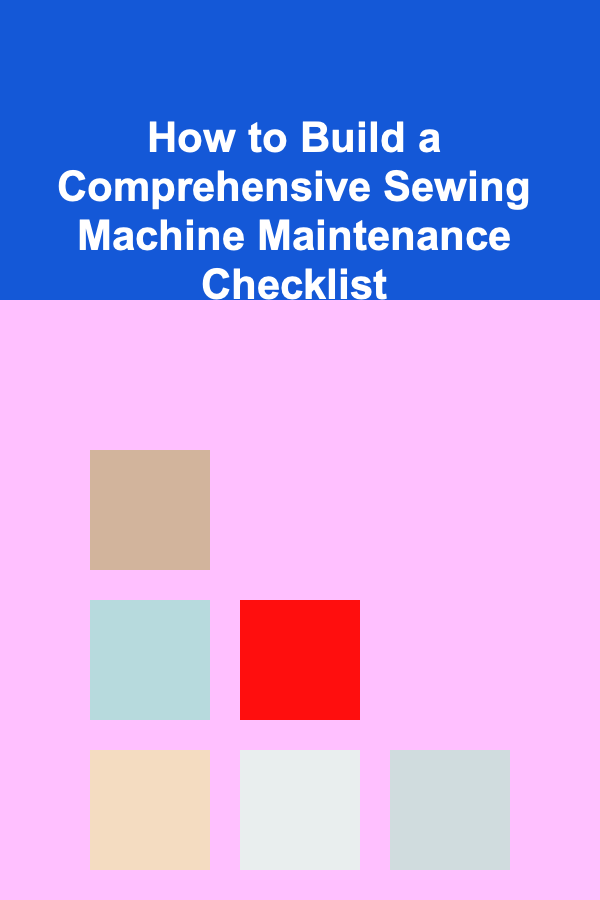
How to Build a Comprehensive Sewing Machine Maintenance Checklist
ebook include PDF & Audio bundle (Micro Guide)
$12.99$5.99
Limited Time Offer! Order within the next:

Sewing machines are essential tools for many individuals, whether they are hobbyists, professionals, or business owners. Keeping a sewing machine in good condition is vital for ensuring its longevity, efficiency, and performance. Regular maintenance will not only keep your sewing machine running smoothly but also prevent costly repairs. To achieve this, it's important to have a comprehensive sewing machine maintenance checklist. This checklist will help you stay on top of routine tasks, identify potential issues early, and ensure that your machine stays in optimal working condition.
In this article, we will explore how to build an effective maintenance checklist for your sewing machine. We will break down key aspects of sewing machine care, outline various maintenance steps, and provide actionable tips to enhance the lifespan of your sewing machine.
Understanding the Importance of Sewing Machine Maintenance
Before diving into the specifics of a maintenance checklist, it's essential to understand why regular maintenance is so important. Sewing machines are intricate mechanical devices that rely on moving parts and delicate components to function properly. Without proper care, dirt, dust, and debris can accumulate, causing the machine to malfunction or work inefficiently. Furthermore, neglected machines are more prone to breakdowns, which could lead to expensive repairs or even irreparable damage.
Regular maintenance not only improves the performance of your sewing machine but also ensures that it works smoothly and produces professional-quality results. A well-maintained machine also offers better stitching accuracy and consistency, reducing the chances of skipped stitches, thread jams, or other issues that can affect the quality of your sewing projects.
Essential Components of a Sewing Machine Maintenance Checklist
Creating a comprehensive checklist requires a focus on the key components of a sewing machine. Each part of the machine needs different attention, and it's crucial to know when and how to perform maintenance on each area. Below is a detailed breakdown of the primary components and their corresponding maintenance tasks.
1. Cleaning the Sewing Machine
Dirt and dust are inevitable when using a sewing machine, as fabric fibers, threads, and lint can accumulate over time. Cleaning your machine is one of the most important maintenance tasks and should be done regularly.
Key Steps:
- Turn off the machine: Always unplug the machine before cleaning to avoid any accidents.
- Clean the exterior: Use a soft cloth to wipe the exterior of the machine, removing dust and grime. Avoid using harsh chemicals or abrasives that can damage the surface.
- Clean the feed dogs: The feed dogs play a critical role in moving the fabric during stitching. Over time, fabric fibers and lint can accumulate around the feed dogs. Use a soft brush to remove any debris.
- Clean the bobbin case and area: Remove the bobbin and clean the bobbin case using a lint brush. Lint can build up in the bobbin area, causing the machine to jam or the thread to tangle.
- Vacuum the inside: If your sewing machine has an accessible compartment, use a small vacuum attachment or compressed air to remove dust and debris from the inner workings of the machine. Be gentle to avoid damaging delicate parts.
- Clean the needle plate: The needle plate can accumulate debris from sewing operations. Use a brush or soft cloth to clean the plate and the surrounding area.
2. Lubrication
Sewing machines have many moving parts that require lubrication to keep running smoothly. Lubricating the machine can reduce friction, prevent wear and tear, and enhance performance.
Key Steps:
- Check the manufacturer's guidelines: Consult the machine's manual to determine the correct type of oil to use and the specific points that need lubrication.
- Lubricate moving parts: Apply a small amount of sewing machine oil to key moving parts, such as the shuttle hook, needle bar, and presser foot bar. Be careful not to over-oil, as excess oil can attract more dirt and debris.
- Lubricate the handwheel: The handwheel is another critical moving part that should be lubricated. A well-lubricated handwheel ensures smooth rotation and helps prevent squeaks or resistance.
3. Changing the Needle
A dull or damaged needle can cause problems such as skipped stitches, thread breakage, and uneven stitching. Changing the needle is a quick and effective way to improve your sewing machine's performance.
Key Steps:
- Change the needle regularly: Even if your needle looks fine, it's a good practice to change it every 6-8 hours of sewing, or when you notice a decline in performance.
- Use the correct needle type: Different types of fabric require different needles. For example, a ballpoint needle is ideal for knit fabrics, while a universal needle is suitable for woven fabrics. Always use the appropriate needle for the material you are working with.
- Ensure proper needle installation: Insert the needle correctly, making sure that it is fully seated in the needle clamp. An improperly installed needle can lead to poor stitching and may damage your machine.
4. Adjusting Tension Settings
The tension of the sewing machine controls how tightly the thread is pulled while sewing. Improper tension can result in thread bunching, loose stitches, or uneven sewing.
Key Steps:
- Test the tension: Before starting a new project, test the tension on a scrap piece of fabric. If you notice uneven stitching, adjust the tension settings accordingly.
- Adjust the top tension: Most sewing machines have a dial or knob to adjust the top thread tension. If the stitches are too tight or too loose, you may need to tweak the tension slightly.
- Check the bobbin tension: If you are still experiencing issues after adjusting the top tension, check the bobbin tension. The bobbin should wind evenly, and the thread should flow freely when pulled.
- Ensure proper threading: Incorrect threading can also cause tension problems. Always follow the machine's threading instructions carefully.
5. Maintaining the Motor and Belts
The motor and belts drive the sewing machine's moving parts. Over time, these components can wear out, affecting the machine's speed, power, and overall performance.
Key Steps:
- Inspect the motor: Regularly inspect the motor for signs of wear or overheating. If you notice unusual sounds or a decrease in sewing speed, it may indicate an issue with the motor.
- Check the belts: Ensure that the belts are properly aligned and not too loose or too tight. Worn-out belts should be replaced to avoid causing motor strain or mechanical failure.
- Lubricate the motor: Some machines have motor components that require occasional lubrication. Check your machine's manual for guidelines on maintaining the motor.
6. Testing the Machine's Functionality
After completing regular cleaning, lubrication, and maintenance tasks, it's important to test the machine to ensure that everything is working as expected.
Key Steps:
- Run a test stitch: After servicing the machine, run a test stitch to check the overall functionality. Pay attention to the stitch quality, tension, and any unusual noises.
- Check for unusual sounds: A well-maintained sewing machine should run smoothly with minimal noise. If you hear grinding or squeaking sounds, it may indicate a mechanical issue.
- Assess the stitch quality: Evaluate the quality of the stitches, looking for evenness, uniformity, and proper tension. If the stitching is uneven, it may signal that the machine needs further adjustment.
7. Storing Your Sewing Machine Properly
Proper storage is essential to protect your sewing machine when it's not in use. Storing the machine correctly helps avoid dust accumulation, damage to parts, and unnecessary wear.
Key Steps:
- Use a dust cover: When not in use, cover your sewing machine with a dust cover to protect it from dust, dirt, and debris.
- Store in a dry environment: Keep your sewing machine in a dry, cool area. Avoid places with high humidity, as moisture can cause rust and other forms of damage.
- Avoid storing near heat sources: Exposure to heat or direct sunlight can damage the machine's plastic or electrical components. Store the machine away from heaters, stoves, or windows.
Building Your Sewing Machine Maintenance Checklist
Now that we've covered the key maintenance tasks for sewing machines, it's time to build a checklist. Here is an example of a comprehensive maintenance checklist you can follow to keep your sewing machine in top shape:
Weekly Maintenance Checklist
- [ ] Clean the bobbin case and surrounding area.
- [ ] Remove lint and dust from the feed dogs and needle plate.
- [ ] Clean the exterior of the sewing machine with a soft cloth.
- [ ] Check the needle for damage and replace it if necessary.
- [ ] Run a test stitch to check stitch quality.
Monthly Maintenance Checklist
- [ ] Lubricate the moving parts as per the manufacturer's instructions.
- [ ] Clean the inside of the machine using compressed air or a small vacuum.
- [ ] Check the tension settings and adjust if needed.
- [ ] Inspect the motor and belts for any signs of wear.
- [ ] Ensure that the machine is properly threaded.
Quarterly Maintenance Checklist
- [ ] Check the belts for wear and alignment.
- [ ] Inspect the needle bar, feed dogs, and presser foot for proper function.
- [ ] Clean and lubricate the machine's internal components.
- [ ] Perform a thorough inspection for any loose parts or screws.
Annual Maintenance Checklist
- [ ] Take the machine to a professional for a full service.
- [ ] Replace any worn-out parts such as the belts or motor components.
- [ ] Deep clean and lubricate all internal mechanisms.
- [ ] Check the overall alignment of the machine and ensure that it's functioning optimally.
Conclusion
Regular maintenance is key to keeping your sewing machine in peak working condition, ensuring that it performs efficiently and produces high-quality stitches. By following a comprehensive maintenance checklist, you can prevent common problems, prolong the life of your machine, and enjoy smoother sewing experiences. Whether you are a seasoned professional or a novice sewer, making a habit of regular maintenance will keep your sewing machine running smoothly for years to come.
Reading More From Our Other Websites
- [Beachcombing Tip 101] Mastering the Art of Beachcombing: Essential Techniques for Every Shoreline Explorer
- [Organization Tip 101] How to Plan Seasonal Fitness Area Updates
- [Small Business 101] Best SEO Strategies Tailored for Micro‑Consulting Firms in Competitive Markets
- [Home Family Activity 101] How to Start a Family History Project: Uncovering Your Roots Together
- [Home Budget 101] How to Budget for Family Life and Keep Home Expenses Under Control
- [Organization Tip 101] How to Use Jars and Containers for Utensil Organization
- [Home Budget 101] How to Save Money on Home Security Systems with a Budget Plan
- [Reading Habit Tip 101] Must-Read Books for High School Students by Subject
- [Organization Tip 101] How to Plan a Luxury Item Swap with Friends
- [Home Cleaning 101] How to Tackle the Most Common Cleaning Problems in Your Home

How to Budget Effectively for a Balanced Financial Future
Read More
How to Collect and Use Customer Feedback: A Checklist for Continuous Improvement
Read More
How to Organize Your Children's Toys with Practical Storage Ideas
Read More
How to Store Pet Supplies in the Kitchen Drawer
Read More
Understanding the Cosmic Microwave Background
Read More
Designing Hinges and Joints for 3D Printing
Read MoreOther Products

How to Budget Effectively for a Balanced Financial Future
Read More
How to Collect and Use Customer Feedback: A Checklist for Continuous Improvement
Read More
How to Organize Your Children's Toys with Practical Storage Ideas
Read More
How to Store Pet Supplies in the Kitchen Drawer
Read More
Understanding the Cosmic Microwave Background
Read More